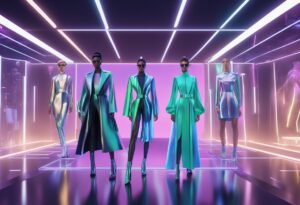Selling clothes in the metaverse is a relatively new concept, but it is rapidly gaining popularity. The metaverse is a virtual world where people can interact with each other and buy and sell virtual goods. As the metaverse grows in popularity, more and more people are looking for ways to sell their clothes in this virtual world. In this blog post, I will provide you a step by step guide on how to sell clothes in the metaverse and tips to make the process easier.
One of the most popular ways to sell clothes in the metaverse is through NFTs or non-fungible tokens. NFTs are unique digital assets that can be bought and sold on the blockchain. They are often used to represent virtual items such as clothing, accessories, and other digital goods. By creating NFTs for their clothes, designers and brands can sell their items in the metaverse and reach a wider audience.
Another way to sell clothes in the metaverse is by creating virtual storefronts. Many metaverse platforms allow users to create their virtual spaces where they can display their clothes and other digital goods. By creating a virtual storefront, designers and brands can showcase their clothes to potential customers and make it easy for them to buy their items.
Understanding the Metaverse
The metaverse is a virtual world that is created by the convergence of physical and digital reality. It is a term used to describe a collective virtual shared space that is created by the convergence of physical and virtual reality.
It is an immersive experience that allows users to interact with a virtual environment in a way that is similar to how they would interact with the physical world. The metaverse is a digital world that is created by the use of advanced technologies such as augmented reality (AR), virtual reality (VR), and mixed reality (MR).
Evolution of Online Gaming and Virtual Reality
The evolution of online gaming and virtual reality has played a significant role in shaping the metaverse. The concept of the metaverse has been around for decades, and it was first introduced in Neal Stephenson’s novel Snow Crash. However, it was not until the development of online gaming and virtual reality that the concept of the metaverse became a reality.
The Role of AR and VR in Shaping the Metaverse
AR and VR technologies have played a significant role in shaping the metaverse. AR technology overlays digital information onto the physical world, while VR technology immerses users in a completely digital world. The combination of these two technologies has created an extended reality (XR) that allows users to interact with the virtual world in a more natural and intuitive way. The metaverse is an example of how AR and VR technologies can be used to create a more immersive and engaging experience for users.
The metaverse is a digital world that is created by the convergence of physical and virtual reality. The evolution of online gaming and virtual reality has played a significant role in shaping the metaverse, and AR and VR technologies have been instrumental in creating an immersive and engaging experience for users.
The metaverse is an example of how advanced technologies can be used to create a shared virtual space that allows users to interact with the virtual world in a more natural and intuitive way.

How to sell clothes in the metaverse
Selling clothes in the metaverse involves several steps, from creating the designs to finding a platform for sales. Here’s a step-by-step guide to help you get started:
- Design Your Virtual Clothing: First, you need to design your virtual garments. This can be done using 3D modeling software where you create digital versions of your clothing.
- Choose a Metaverse Platform: Select a metaverse platform that supports the selling and trading of virtual goods. Platforms like Decentraland and The Sandbox are popular choices.
- Create Your Store: Build a virtual store within the metaverse platform where users can view and purchase your clothing. This might involve buying or renting virtual land depending on the platform’s requirements.
- Mint NFTs for Your Clothing: Turn your virtual clothing into Non-Fungible Tokens (NFTs) to establish ownership and authenticity. This typically involves using a blockchain like Ethereum and might incur some cost.
- Set Up a Payment System: Integrate a payment system that can handle cryptocurrency transactions, as this is the common currency used in the metaverse.
- Market Your Brand: Use social media, metaverse events, and partnerships to market your virtual clothing brand.
- Engage with the Community: Interact with the community to understand what users want and to create a loyal customer base.
- Manage Your Inventory: Keep track of your sales and inventory to understand what designs are most popular and to plan for new releases.
- Analyze and Adapt: Use sales data to refine your product offerings and marketing strategies.
The Intersection of Fashion and Technology

The fashion industry has always been at the forefront of innovation, and the emergence of the metaverse has provided a new platform for the industry to explore. The metaverse is a virtual world that allows users to interact with each other and their surroundings in a digital space. As such, it presents an opportunity for fashion brands to create innovative experiences for their customers.
Digital Fashion in the Metaverse
Digital fashion is a growing trend in the metaverse. It involves designing and creating virtual clothing that can be worn by avatars in the virtual world. This presents a new way for fashion brands to showcase their designs and reach a wider audience. In addition, digital fashion allows for more sustainable practices, as there is no waste in the production process.
Blockchain Technology and NFTs
Blockchain technology and non-fungible tokens (NFTs) are also playing a significant role in the intersection of fashion and technology. NFTs allow for the ownership and transfer of digital assets, including virtual clothing. This presents an opportunity for fashion brands to monetize their digital designs and create a new revenue stream.
The Emergence of Virtual Fashion Brands
The emergence of virtual fashion brands is another exciting development in the intersection of fashion and technology. These brands create virtual clothing that can be worn in the metaverse, and they are gaining popularity among users. Virtual fashion brands present a new way for designers to showcase their creativity and reach a wider audience.
The intersection of fashion and technology is an exciting space that is constantly evolving. The metaverse presents a new platform for fashion brands to create innovative experiences for their customers, while digital fashion, blockchain technology, and virtual fashion brands are all playing significant roles in shaping the future of the industry.
Setting Up Your Virtual Store

Creating a virtual store is an essential step in selling clothes in the metaverse. It is important to create an engaging shopping experience that will attract and retain customers. Here are some tips to help you set up your virtual store.
Creating an Engaging Shopping Experience
To create an engaging shopping experience, it is important to consider the customer’s perspective. The virtual store should be designed to be user-friendly and easy to navigate.
The use of high-quality images and videos can help to showcase the clothes and create an immersive shopping experience. Incorporating interactive elements such as 360-degree product views and virtual try-on features can help to enhance the shopping experience.
Integrating AI and Creative Design
Integrating AI and creative design can help to create a more personalized shopping experience for customers. AI can be used to analyze customer data and provide personalized recommendations based on their preferences. Creative design can be used to create unique and visually appealing virtual store designs that stand out from the competition.
Virtual Real Estate Considerations
When setting up a virtual store, it is important to consider virtual real estate. This includes the location of the store within the virtual world, as well as the size and design of the store. Choosing a prime location within the virtual world can help to attract more customers and increase visibility. Designing a sustainable virtual store can help to reduce the environmental impact of the virtual world.
Setting up a virtual store in the metaverse requires careful consideration of the customer base and the virtual world itself. By creating an engaging shopping experience, integrating AI and creative design, and considering virtual real estate, retailers can successfully sell clothes in the metaverse.
Marketing and Branding in the Metaverse
The metaverse is a new and exciting space for fashion brands to market and sell their products. With the increasing popularity of metaverse platforms, it has become essential for brands to establish a strong brand identity and marketing strategy to succeed in this space.
Building a Brand Identity
Creating a unique brand identity is crucial in the metaverse. A brand’s identity should represent its values and mission while also being visually appealing to the audience. In the metaverse, brands can experiment with different styles and aesthetics to create a unique identity.
Leveraging Social Media and Metaverse Platforms
Social media platforms like Instagram and TikTok have become essential tools for fashion brands to market their products. In the metaverse, social media platforms play an even more significant role in reaching potential customers.
Brands can leverage social media platforms to showcase their products and engage with their audience. Metaverse platforms like Decentraland and Somnium Space also provide opportunities for brands to create immersive experiences for their customers.
Collaborations with Gaming and Luxury Brands
Collaborations with gaming and luxury brands can help fashion brands reach new audiences and create unique experiences for their customers. Luxury brands like Balenciaga, Gucci, Adidas, Burberry, Prada, and Louis Vuitton have already started exploring the metaverse space. Collaborations with gaming brands can also help fashion brands tap into the gaming audience, which has a significant overlap with the metaverse audience.
Marketing and branding in the metaverse require a unique approach that combines traditional marketing strategies with innovative ideas. Fashion brands that establish a strong brand identity, leverage social media and metaverse platforms, and collaborate with gaming and luxury brands can succeed in this space.

Monetization and Revenue Streams
Selling and Trading Digital Assets
One of the most popular ways to monetize in the metaverse is by selling and trading digital assets. These assets can range from virtual clothing items to unique pieces of art. Non-Fungible Tokens (NFTs) are a type of digital asset that can be used to represent ownership of unique items in the metaverse. NFTs have become increasingly popular in recent years, with some selling for millions of dollars.
Fashion brands can leverage NFTs to create unique and limited-edition virtual clothing items. These items can then be sold to collectors and fans in the metaverse. By creating scarcity and exclusivity, fashion brands can drive up demand and increase revenue streams.
Cryptocurrencies and Their Impact
Cryptocurrencies are another way to monetize in the metaverse. Cryptocurrencies such as Bitcoin and Ethereum have gained mainstream adoption in recent years and can be used to buy and sell virtual goods in the metaverse.
Fashion brands can accept cryptocurrencies as payment for virtual clothing items, providing a seamless and secure payment option for customers. Cryptocurrencies also offer the potential for increased revenue streams, as the value of cryptocurrencies can fluctuate rapidly.
Targeting the Gen Z Market
Gen Z is a demographic that has grown up with technology and is comfortable with digital interactions. They are also the largest generation in the world, making up 32% of the global population.
Fashion brands can target the Gen Z market by creating virtual clothing items that appeal to their interests and preferences. For example, streetwear and athleisure are popular styles among Gen Z, and fashion brands can create virtual clothing items that reflect these styles. By targeting the Gen Z market, fashion brands can tap into a large and growing demographic and increase revenue streams.
Fashion brands can monetize in the metaverse by selling and trading digital assets, accepting cryptocurrencies as payment, and targeting the Gen Z market. By leveraging these revenue streams, fashion brands can increase revenue and reach a wider audience in the metaverse.
Frequently Asked Questions
What platforms are available for selling virtual clothing in the metaverse?
There are several platforms available for selling virtual clothing in the metaverse, including Decentraland, Emperia, and Horizon Worlds. Each platform has its own unique features and benefits, so it’s important to do your research and choose the one that best fits your needs and goals.
What are the steps to create and list digital fashion items in Decentraland?
To create and list digital fashion items in Decentraland, you’ll need to first create a 3D model of your clothing item using a program like Blender. Once you’ve created your model, you can upload it to Decentraland’s marketplace, where it will be listed for sale. It’s important to note that there are fees associated with listing items on Decentraland, so be sure to factor those into your pricing strategy.
How can designers collaborate with digital fashion studios like The Fabricant for metaverse apparel?
Designers can collaborate with digital fashion studios like The Fabricant by reaching out to them directly and expressing their interest in working together. The Fabricant offers a range of services, including 3D modeling, animation, and virtual clothing design, so there are many opportunities for collaboration.
What is the process for setting up a virtual store in a metaverse environment such as Emperia?
The process for setting up a virtual store in a metaverse environment such as Emperia will vary depending on the platform you choose. In general, you’ll need to create a 3D model of your store and upload it to the platform’s marketplace. From there, you can set up your virtual storefront and start selling your products. It’s important to note that there may be fees associated with setting up a virtual store, so be sure to factor those into your budget.
How can customers try on virtual clothes before purchasing in the metaverse?
There are a few different ways that customers can try on virtual clothes before purchasing in the metaverse. Some platforms, like Horizon Worlds, offer built-in try-on features that allow users to see how clothing items will look on their avatars. Other platforms may require users to download separate software or plugins in order to try on virtual clothing.
What are the legal considerations when selling virtual fashion in the metaverse?
When selling virtual fashion in the metaverse, it’s important to consider the legal implications of your business. For example, you may need to obtain licenses or permissions to use certain trademarks or logos in your designs. You’ll need to ensure that your products comply with any relevant intellectual property laws, such as copyright and trademark laws. It’s always a good idea to consult with a legal professional to ensure that you’re operating within the law.




